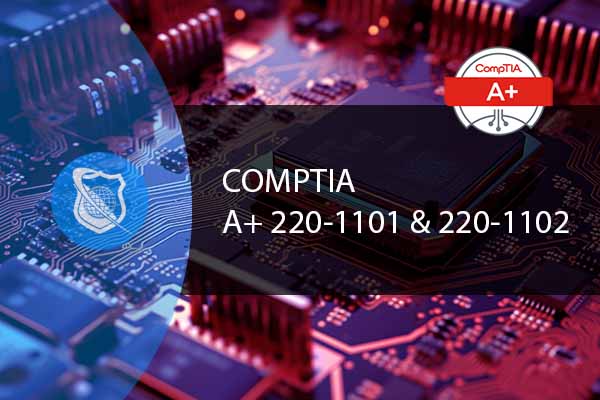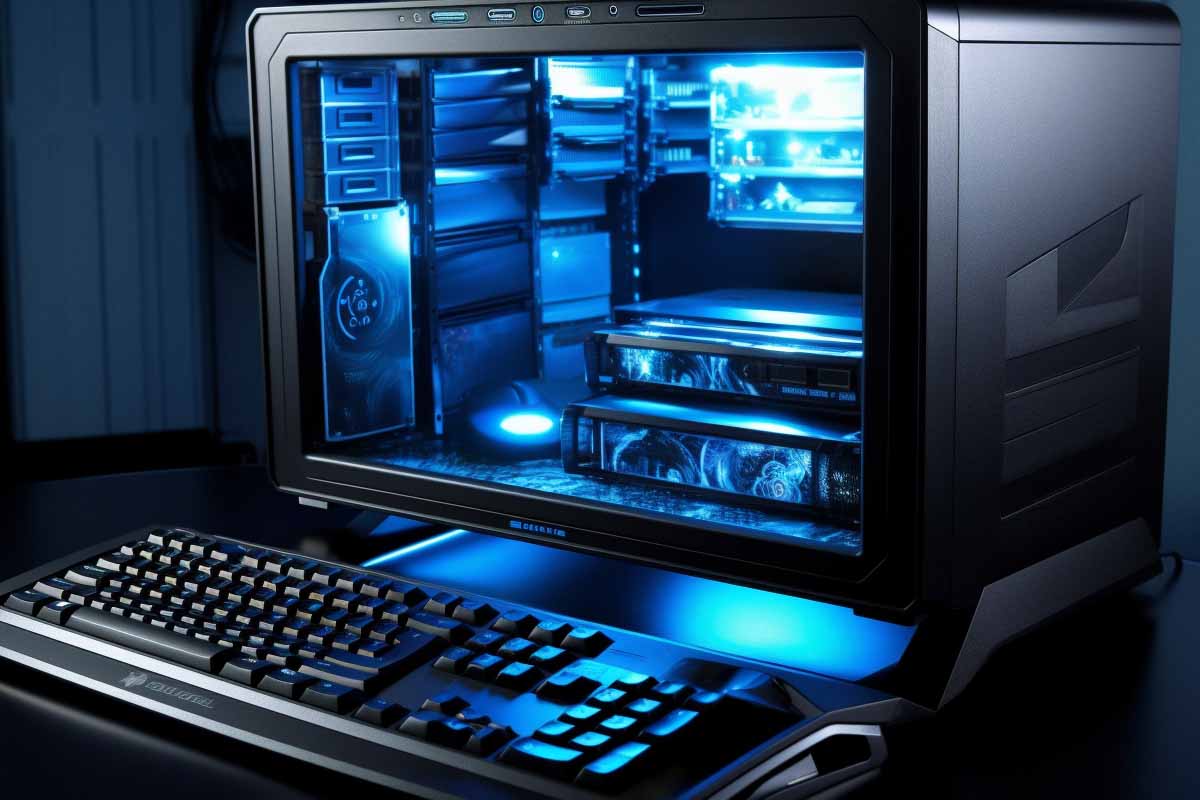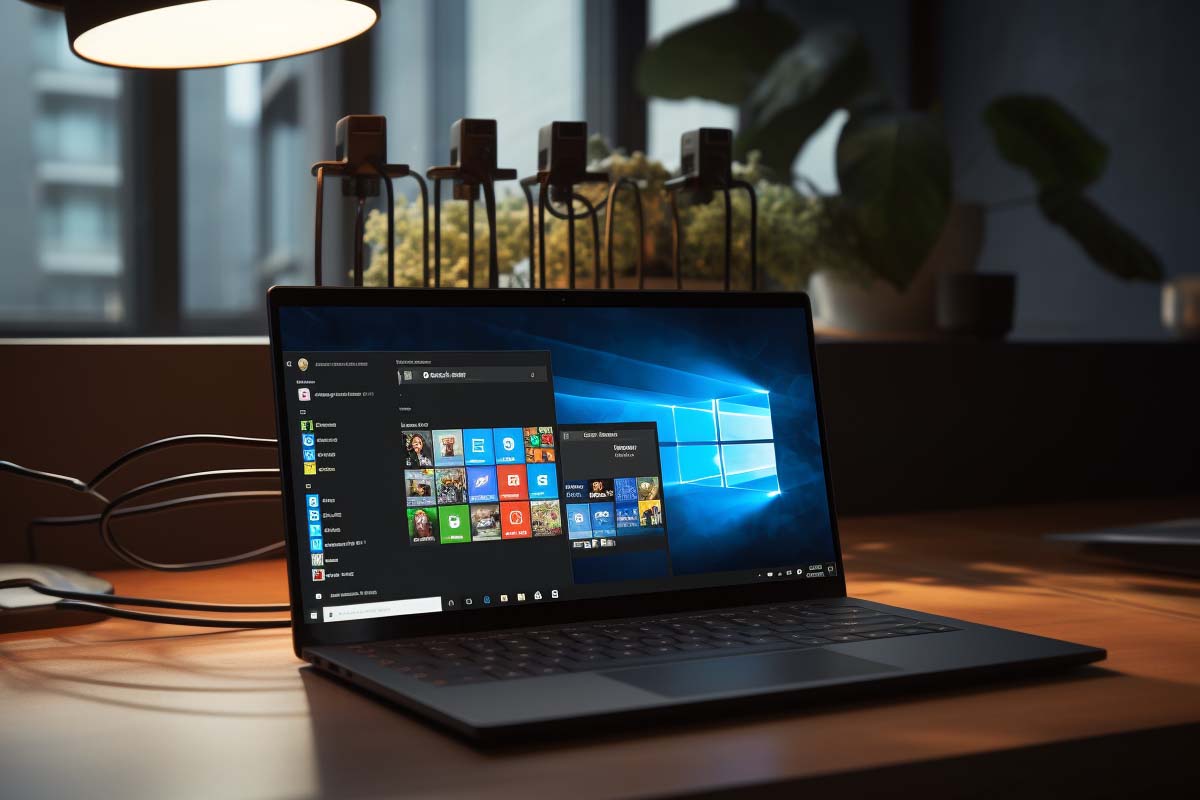Welcome aboard to the inaugural piece in our series of blogs dedicated to dissecting the intricacies of the CompTIA A+ certification domains, this being the first and is on the CompTIA A+ Hardware domain. This series is your compass through the vast landscape of CompTIA A+ certification, a credential esteemed by IT professionals globally. We’ll start our journey by delving deep into the Hardware domain, a critical domain that serves as the bedrock of your path to becoming A+ certified. In this article, we aim to provide you with a compass and map, guiding you through the critical components of the Hardware domain. These are the foundational building blocks that every student should not only understand but also master as they navigate the A+ certification landscape.
CompTIA A+ Hardware domain is the first in the series
| Domain | Description |
|---|---|
| 01 – Hardware | Computer components and troubleshooting |
| 02 – Networking | Networking concepts and troubleshooting |
| 03 – Mobile Devices | Mobile device hardware and troubleshooting |
| 04 – Hardware & Network Troubleshooting | Diagnosing and resolving issues |
| 05 – Operating Systems | OS features, installation, and management |
| 06 – Software Troubleshooting | Common software issues and solutions |
| 07 – Security | Basic security concepts and practices |
| 08 – Virtualization & Cloud | Introduction to virtualization and cloud |
| 09 – Operational Procedures | IT best practices and procedures |
Unpacking the Significance of the CompTIA A+ Hardware domain
The Hardware domain within the CompTIA A+ certification exam isn’t just another section; it’s the cornerstone, the very foundation upon which your IT career can be built. Within its purview, you’ll explore a vast and diverse realm, delving into topics that revolve around the core components of computing, the intricate world of peripherals, and the indispensable skill of troubleshooting hardware issues. Understanding this domain isn’t merely a requirement for the exam; it’s an essential pillar of IT knowledge that every aspiring IT professional should grasp with both hands.

CompTIA A+ Course
Embark on a transformative journey into the world of IT with our CompTIA A+ Certification course. From mastering hardware and network devices to software troubleshooting and security procedures, this comprehensive course equips you with the skills to excel in the ever-evolving tech landscape. Take the next step in your career and prepare for the CompTIA A+ exams!
The Breadth of the CompTIA A+ Hardware domain
To appreciate the significance of the Hardware domain fully, let’s break down the scope of its coverage:
| Hardware Domain Area | Description |
|---|---|
| Computer Components | Dive into the inner workings of computers, understanding Central Processing Units (CPUs), the brain of the system; memory modules (RAM) dictating performance; storage devices like hard drives and SSDs; the intricate circuitry of motherboards; graphics cards for rendering visuals; and power supplies that provide energy to the components. Master their roles, functions, and interplay, akin to deciphering the language of technology. |
| Peripherals | Extend beyond core components to peripherals. These include everyday devices like keyboards, mice, monitors, printers, and external storage solutions. It’s not just about plugging in devices but also knowing how to connect, configure, and troubleshoot them efficiently. These seemingly mundane devices play pivotal roles in the end-user’s computing experience. |
| Troubleshooting Hardware | Master the craft of troubleshooting hardware issues. Hone the skill of diagnosing and resolving problems swiftly. This domain involves a systematic approach to identifying faulty components, loose connections, and the complex interaction between hardware and software that can lead to perplexing issues. Practical experience gained here will make you a troubleshooter extraordinaire. |
| Hardware Maintenance | Learn essential hardware maintenance tasks, from routine cleaning to preventive measures and component upgrades. This knowledge is a cost-effective lifesaver in real-world IT scenarios, ensuring systems run smoothly and efficiently. |
| Hardware Interfaces | Discover the intricate world of hardware interfaces and connectors, including USB ports, Thunderbolt, Bluetooth, display connectors like HDMI, VGA, and DisplayPort, audio jacks, and network interfaces. Understanding these interfaces goes beyond connection; it involves ensuring compatibility and efficiency. |
Computer Components: The Machinery of the Digital World
In the realm of IT, computer components are the cogs and gears of the digital machinery. They are the building blocks that bring life to the world of technology, and in the Hardware domain of the CompTIA A+ certification exam, you’ll embark on a journey to understand their inner workings. Let’s delve into these critical components:
Central Processing Units (CPUs): Imagine the CPU as the brain of a computer. It’s where the magic happens, where instructions are processed, and calculations are performed. Understanding CPU architecture, clock speeds, cores, and threading is akin to deciphering the very language of computation. It’s the heart of the computer that determines its capabilities.
Memory Modules (RAM): RAM, or Random Access Memory, is the short-term memory of a computer. It dictates performance and responsiveness. Learning about RAM capacity, types (DDR3, DDR4, etc.), and its role in multitasking will empower you to optimize a computer’s performance.
Storage Devices: In the realm of storage, you’ll explore the differences between hard disk drives (HDDs) and solid-state drives (SSDs). You’ll learn about storage capacities, transfer speeds, and the importance of storage in data retention. Understanding these components is like knowing where a computer stores its memories.
Motherboards: Motherboards are the intricate circuit boards that connect and power all the components. They house the CPU, RAM, and provide slots for peripherals. Knowing motherboard form factors, chipset compatibility, and the significance of BIOS/UEFI settings is like deciphering the blueprint of a computer’s architecture.
Graphics Cards: Graphics cards, or GPUs (Graphics Processing Units), are responsible for rendering visuals on a computer screen. In this domain, you’ll delve into GPU types, graphics memory (VRAM), and their role in gaming and multimedia. It’s like exploring the artist’s palette that brings digital worlds to life.
Power Supplies: Power supplies are the silent heroes of computing, providing the necessary energy for all components to function. Understanding power supply wattage, connectors, efficiency ratings, and the importance of stable power delivery is akin to mastering the electrical backbone of a computer.
Comprehending these computer components isn’t just about knowing what they are; it’s about understanding how they work together in harmony. It’s akin to learning the intricate dance of a symphony, where each instrument plays a vital role in creating a beautiful composition. These components collectively form the core of IT hardware, and your knowledge of their roles and functions is the key to becoming a proficient IT professional.

CompTIA A+ Course
Embark on a transformative journey into the world of IT with our CompTIA A+ Certification course. From mastering hardware and network devices to software troubleshooting and security procedures, this comprehensive course equips you with the skills to excel in the ever-evolving tech landscape. Take the next step in your career and prepare for the CompTIA A+ exams!
Peripherals: The Everyday Enablers of IT
Beyond the core components that reside within a computer’s casing, peripherals extend the horizon of the hardware domain. They are the everyday enablers of IT, the devices that users interact with directly. However, their significance goes beyond mere plug-and-play. Let’s explore the world of peripherals:
Keyboards: Keyboards are the digital translators of human thought. Understanding keyboard layouts, key types (mechanical, membrane), and shortcuts is like mastering a language for efficient communication with a computer.
Mice: Mice, with their clicks and scrolls, offer precise control in the digital world. Learning about mouse types (optical, laser), DPI (dots per inch), and ergonomic design is akin to wielding a digital paintbrush.
Monitors: Monitors are the windows to the digital realm. In this domain, you’ll explore monitor resolutions, refresh rates, panel types (LCD, LED, OLED), and calibration. It’s like discovering the canvas on which digital art is displayed.
Printers: Printers bring digital documents into the physical world. Understanding printer types (laser, inkjet), connectivity options, and troubleshooting print issues is akin to mastering the art of replication in the physical realm.
External Storage Solutions: External hard drives and SSDs are the digital vaults of data. Learning about storage capacities, data transfer interfaces (USB, Thunderbolt), and backup strategies is akin to becoming a digital archivist.
But the peripherals domain isn’t just about knowing these devices; it’s about harnessing their potential. It’s about knowing how to connect them, configure them to suit your needs, and troubleshoot them when they don’t behave as expected. These seemingly mundane devices are the conduits through which users interact with the digital world, making them pivotal in the end-user’s computing experience.
Troubleshooting Hardware Issues: Unraveling the Mysteries
Troubleshooting is both an art and a science in the IT world, and within the Hardware domain of the CompTIA A+ certification exam, you’ll embark on a journey to master this craft. Let’s dive deep into this critical skill:
The Craft of Troubleshooting: Troubleshooting is the ability to diagnose and resolve hardware problems swiftly and effectively. It’s like being a detective in the digital world, searching for clues and solving puzzles. This domain equips you with a systematic approach, turning you into a troubleshooter extraordinaire.
Diagnosing Faulty Components: One of the key skills you’ll hone is the art of identifying faulty components. Just like a doctor identifies symptoms to diagnose an illness, you’ll learn how to recognize signs that point to specific hardware failures. Whether it’s a malfunctioning CPU, a defective RAM module, or a failing hard drive, you’ll become skilled at isolating the culprit.
Taming Loose Connections: Loose connections can be a bane of computer systems, causing erratic behavior and mysterious crashes. Within this domain, you’ll learn how to trace and secure connections, ensuring that everything is snug and secure. It’s like tightening the screws and bolts of a complex machine, bringing it back to optimal performance.
The Hardware-Software Dance: Hardware issues often blur the lines with software problems. Understanding how hardware and software interact is crucial. Sometimes, seemingly perplexing issues have roots in both realms. You’ll become adept at discerning where the problem truly lies and how to tackle it effectively.
Real-World Troubleshooting: Practical experience gained in this domain is invaluable. It’s not just about theoretical knowledge; it’s about rolling up your sleeves and diving into real-world scenarios. You’ll learn how to approach different problems, adapt to unique situations, and become the go-to expert when hardware issues arise.
In essence, troubleshooting hardware issues is like becoming the IT doctor for computers. You’ll learn how to diagnose ailments, prescribe solutions, and nurse ailing systems back to health. This skill is not just crucial for the A+ exam; it’s a foundation for a successful IT career.

CompTIA A+ Course
Embark on a transformative journey into the world of IT with our CompTIA A+ Certification course. From mastering hardware and network devices to software troubleshooting and security procedures, this comprehensive course equips you with the skills to excel in the ever-evolving tech landscape. Take the next step in your career and prepare for the CompTIA A+ exams!
Hardware Maintenance: The IT Caretaker
Just as cars need regular maintenance to stay roadworthy, computer systems require tender loving care to keep running smoothly. In this segment of the Hardware domain, you’ll explore the world of hardware maintenance:
Routine Cleaning: Computers are dust magnets, and over time, dust can clog fans and heat sinks, leading to overheating and reduced performance. Here, you’ll learn the importance of routine cleaning, much like giving a car an oil change. You’ll discover how to safely clean components and keep systems in pristine condition.
Preventive Measures: Prevention is often better than cure. In this domain, you’ll delve into preventive maintenance tasks. You’ll learn about strategies to prolong hardware life, such as proper ventilation, ensuring stable power, and safeguarding against power surges. It’s like installing airbags and seatbelts to keep a car safe.
Hardware Upgrades: Just as a car might need an engine upgrade for better performance, computer systems can benefit from hardware upgrades. You’ll explore the art of upgrading components like RAM, hard drives, and graphics cards to keep systems up-to-date and efficient. It’s like giving a computer a boost in horsepower.
Cost-Effective Lifesaver: The knowledge you gain in hardware maintenance is a cost-effective lifesaver in real-world IT scenarios. It can prevent costly hardware failures, extend the lifespan of systems, and keep end-users happy and productive. It’s an essential skill in your IT toolbox.
In essence, hardware maintenance is like being the caretaker of IT systems. You’ll ensure they remain healthy, efficient, and free from avoidable issues. This domain is not just about theoretical knowledge; it’s about practical skills that can save time, money, and headaches in the IT world.
Hardware Interfaces and Connectors: The Digital Pioneers
The Hardware domain introduces you to the intricate world of interfaces and connectors, the digital pioneers that bridge the gap between devices. Let’s dive into this realm:
USB Ports: USB ports are the universal connectors of the digital world. Understanding USB standards (USB 2.0, USB 3.0, USB-C), their data transfer speeds, and compatibility is like speaking the lingua franca of modern computing.
Thunderbolt and Beyond: Thunderbolt technology takes connectivity to the next level. You’ll explore Thunderbolt interfaces, their blazing-fast data transfer rates, and their versatility in connecting high-end devices. It’s like being at the forefront of digital innovation.
Bluetooth Connectivity: Bluetooth is the magic behind wireless peripherals. Learning about Bluetooth standards, pairing devices, and troubleshooting Bluetooth issues is akin to becoming a wireless sorcerer.
Display Connectors: HDMI, VGA, DisplayPort – these connectors bring visuals to life. Understanding their differences, resolutions, and compatibility with monitors and graphics cards is like having a backstage pass to the theater of digital displays.
Audio Jacks: Audio jacks carry sound to our ears. Here, you’ll explore audio connector types, stereo vs. mono, and the nuances of connecting audio devices. It’s like being an audio engineer for digital soundscapes.
Network Interfaces: Network interfaces are the gateway to the digital world. In this domain, you’ll learn about Ethernet ports, wireless adapters, IP addressing, and network troubleshooting. It’s like being the captain of the digital ship, navigating through the vast sea of data.
Understanding these interfaces and connectors isn’t just about knowing how to plug devices in; it’s about ensuring compatibility and efficiency in the digital realm. It’s about speaking the language of devices, enabling them to work seamlessly together.

CompTIA A+ Course
Embark on a transformative journey into the world of IT with our CompTIA A+ Certification course. From mastering hardware and network devices to software troubleshooting and security procedures, this comprehensive course equips you with the skills to excel in the ever-evolving tech landscape. Take the next step in your career and prepare for the CompTIA A+ exams!
Wrapping up CompTIA A+ Hardware Domain
In essence, the CompTIA A+ Hardware domainis the entry point into the heart of IT hardware. It’s a realm where you’ll decipher the language of machines and gain the tools to maintain and troubleshoot them effectively. It’s a domain where you’ll acquire the skills that can set you on a path towards a rewarding career in IT.
Stay with us as we continue this journey through the CompTIA A+ certification domains, exploring each one comprehensively to equip you with the knowledge and skills needed to excel in the IT world. Next up, we’ll tackle the Networking domain, where we’ll unravel the mysteries of networking concepts, protocols, and the art of troubleshooting common network problems. Stay tuned for more insights and guidance on your A+ certification path.
You may also like:
CompTIA A+ Exam : Understanding the Two Core Exams (220-1001 & 220-1002)
CompTIA A+ Course : 10 Tips for Passing the Exam on Your First
CompTIA A+ Jobs: Top 5 Roles for Certified Professionals
CompTIA A+ Certification: The Perfect Certification to Begin Your IT Career
FAQs for CompTIA A+ Hardware
What is the significance of the CompTIA A+ Hardware domain in the certification exam?
The CompTIA A+ Hardware domain is of paramount importance in the certification exam as it forms the foundation of IT knowledge. It covers critical components, peripherals, troubleshooting, maintenance, and interfaces, which are fundamental for IT professionals. Mastery of this domain is essential for exam success and a successful IT career.
How do I prepare for the CompTIA A+ Hardware domain?
To prepare for the CompTIA A+ Hardware domain, start by studying the official CompTIA A+ study materials, which align with exam objectives. Create a structured study plan, use practice tests, and engage with the IT community for insights. Hands-on experience with computer components and peripherals is invaluable. Remember to focus on SEO keyword “CompTIA A+ Hardware” when seeking study resources.
Can you explain the role of computer components in the CompTIA A+ Hardware domain?
Certainly. Computer components, including CPUs, RAM, storage devices, motherboards, graphics cards, and power supplies, are the core of IT hardware. Understanding their roles and functions is crucial for CompTIA A+ Hardware. CPUs are the brain, RAM dictates performance, storage stores data, motherboards connect everything, graphics cards render visuals, and power supplies provide energy.
What are the key maintenance tasks covered in the CompTIA A+ Hardware domain?
In the CompTIA A+ Hardware domain, you’ll learn essential maintenance tasks like routine cleaning to prevent dust buildup, preventive measures to ensure system longevity, and upgrading components to keep systems efficient. These tasks are like regular check-ups for computer systems, ensuring they run smoothly and cost-effectively.
How does understanding hardware interfaces and connectors benefit IT professionals in the CompTIA A+ Hardware domain?
Understanding hardware interfaces and connectors is crucial in the CompTIA A+ Hardware domain. It allows IT professionals to connect devices efficiently and ensure compatibility. Familiarity with USB ports, Thunderbolt, Bluetooth, display connectors (HDMI, VGA, DisplayPort), audio jacks, and network interfaces enables seamless interaction with a wide range of hardware, a key skill for the A+ exam and real-world IT scenarios.
Explore Our Comprehensive 9-Part Series on CompTIA Network+ Exam Domains
Dive deep into the world of networking with our extensive 6-part blog series designed to be your ultimate guide for the CompTIA A+ Exam. Each blog focuses on a specific domain, providing expert insights, study tips, and real-world applications to help you master the subject and ace the exam. Click on the titles below to explore each domain in detail.
CompTIA A+ Hardware : A Comprehensive Domain Overview (1 of 9 Part Series)
CompTIA A+ Networking: Unveiling the Essentials of the Domain (2 of 9 Part Series)
Mobile Devices CompTIA A+ : Understanding the Domain (3 of 9 Part Series)
CompTIA A+ Hardware and Network Troubleshooting: A Comprehensive Domain Guide (4 of 9 Part Series)
CompTIA A+ Operating Systems : Deep Dive Into The Domain (5 of 9 Part Series)
CompTIA A+ Certificate : Software Troubleshooting (6 of 9 Part Series)
CompTIA A+ Security : A Deep Dive Into The Domain Fundamentals (7 of 9 Part Series)
CompTIA A+ Cloud Computing and Virtualization: A Comprehensive Domain Guide (8 of 9 Part Series)
CompTIA A+ Operational Procedures: A Deep Dive into the Domain (9 of 9 Part Series)

























1 thought on “Comptia A+ Hardware : A Comprehensive Domain Overview (1 of 9 Part Series)”
Hi my friend! I want to say that this article is amazing, nice written and include almost all significant infos. I would like to see more posts like this.